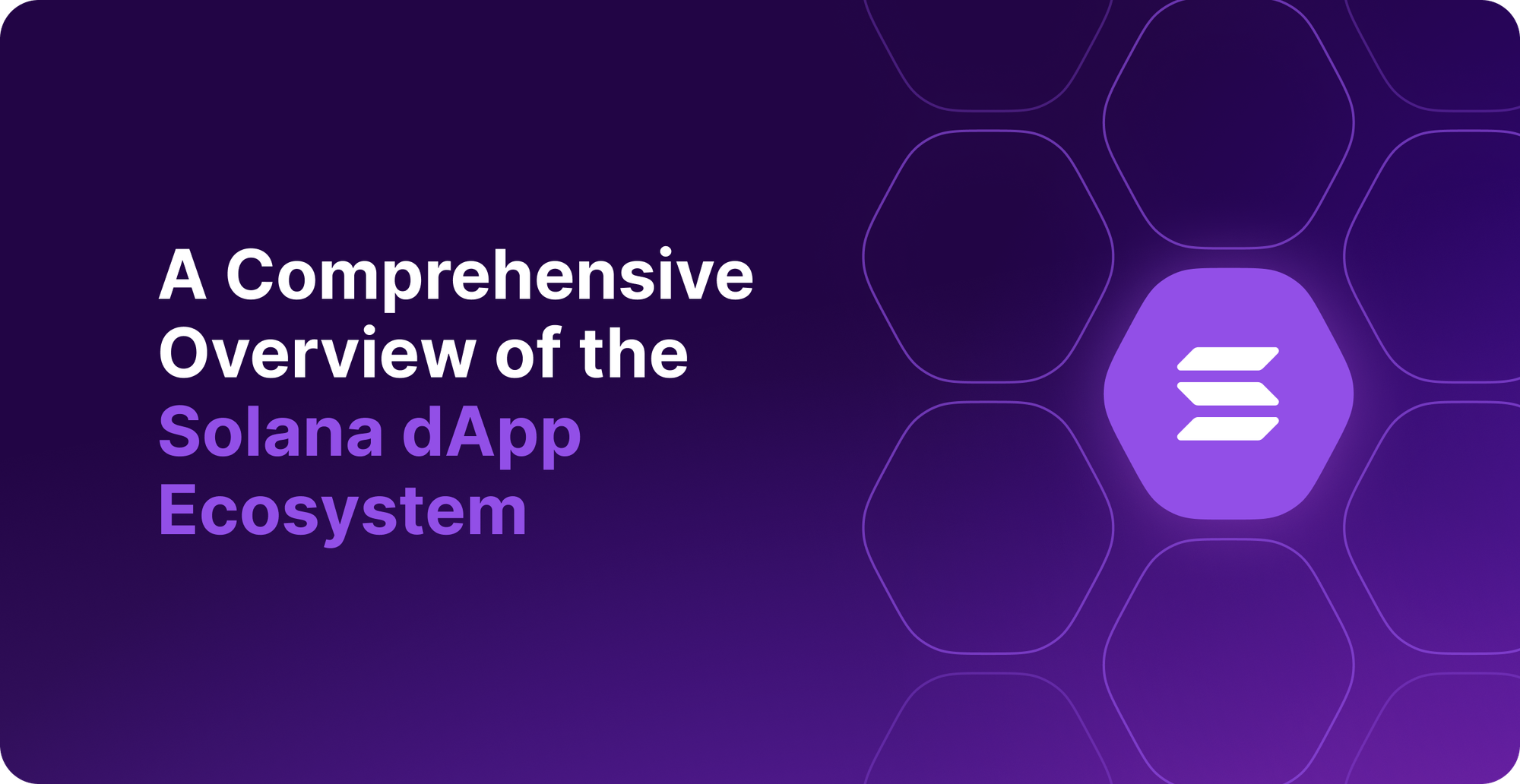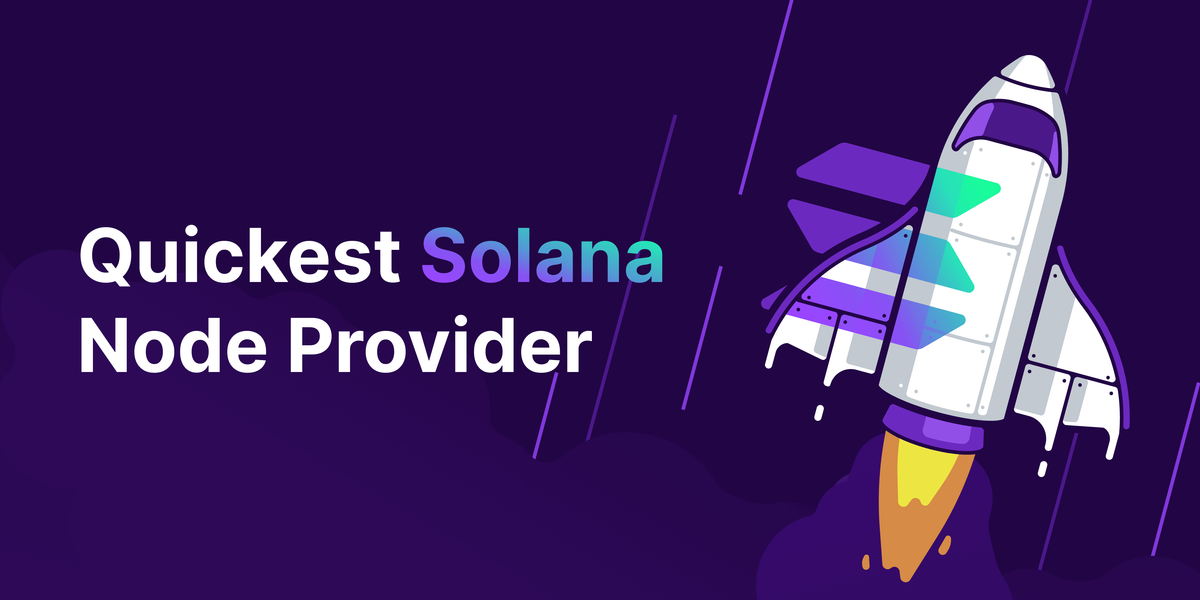A Comprehensive Overview of the Solana dApp Ecosystem
Solana is a high-performance blockchain that leverages the Proof of History (PoH) consensus mechanism and parallel transaction processing to offer high throughput and low transaction costs.

Solana has shown amazing growth recently for both user and developer interests.
Decentralized finance (DeFi) on Solana rose to $1482M in Q4 2023, a 505.0% YoY change from 2022. And the average DEX volume rose to $416.1M in Q4 2023, witnessing a 715.3% yearly increase.
It’s also the top non-EVM chain for new developers — the number of developers building on Solana has also grown 10x from 2020 to 2023. And throughout 2023, 3-month developer retention increased from 31% to >50%. This recent uptick in developer interest is thanks to the improved developer onboarding.
Add to this, Solana's speed and efficiency, coupled with nearly a year-long streak of no downtime — the network is truly firing all cylinders, at the moment.
One result of this is a vibrant dApp — decentralized application — ecosystem that Solana currently houses. From DeFi to DePIN (decentralized physical infrastructure networks) — the Solana dApp ecosystem is thriving and expanding, at scale.
In this blog, we will explore the ecosystem, why Solana is growing, and some key players that are fueling growth. In the end, we also have a quick breakdown of how developers can build dApps on Solana.
Exploring Solana’s dApp ecosystem
Solana is a high-performance blockchain that leverages the Proof of History (PoH) consensus mechanism and parallel transaction processing to offer high throughput and low transaction costs. dApps on Solana leverage these attributes to differentiate themselves in terms of performance, speed, and cost-efficiency.
Throughput
Ethereum’s single-threaded model allows it to process only 12 transactions per second. In contrast, Solana averages more than 2,000 TPS, thanks to its parallel transaction capabilities.
This level of throughput means dApps built on Solana can handle high transaction volumes without causing network congestion.
Transaction costs
Transaction fees on Solana, on the other hand, are predictable and usually around $0.0001 due to its localized fee market system, where transactions that don't overlap with each other are executed on separate threads.
This mechanism ensures that congestion in one part of the system doesn’t lead to increased fees across the entire system.
Transaction finality
dApps built on Ethereum often experience longer transaction confirmation times, especially during periods of network congestion due to its limited scalability.
However, Solana’s 'optimistic confirmation' confirms transactions when two-thirds of validators have voted on it. This helps the network achieve transaction finality in 0.4 seconds, making it advantageous for gaming applications, trading platforms, and other types of dApps that require quick confirmation times.
Now that we’ve understood the benefits of building on Solana, let’s take a closer look at the different types of dApps in the ecosystem.
Interested in building on Solana? Check out the fundamentals guide 👇
Decentralized Finance on Solana
Solana's remarkable combination of low latency, high throughput, and minimal transaction fees negates the need for scalability solutions and enhances DeFi solutions. This efficiency is particularly evident when comparing transfer volumes rather than Total Value Locked (TVL), underscoring Solana's design for highly capital-efficient DeFi activities. Currently, Solana boasts a TVL of $2.754 billion. Furthermore, it's noteworthy that Jupiter Exchange, the largest aggregator on Solana, frequently surpasses Ethereum's Uniswap V3 in 24-hour DEX trading volume, highlighting Solana's growing dominance and efficiency in facilitating DeFi transactions.
We’ve listed some of the most popular DeFi apps on Solana below:
Liquid Staking/MEV
Marinade Finance optimizes staking for users by monitoring all Solana validators and delegating tokens to over 100 best-performing ones.
In return for staking SOL, users receive mSOL. This liquid staking token can be used as collateral in other DeFi applications or staked to receive $MNDE, the platform’s governance token.
Jito Network
The Jito Network is a permissionless liquid staking protocol that maximizes Miner Extractable Value (MEV) rewards for users. It utilizes its own high-performing Solana validator client, Jito-Solana, which actively searches for and captures MEV opportunities through transaction re-ordering, arbitrage, and other strategies.
Payments
Sphere acts as an operating system for stablecoins, facilitating seamless, secure, and fast cross-border payments for merchants in emerging markets. By serving as the critical link between users and stablecoins through intuitive graphic user interfaces (GUIs), Sphere simplifies the integration of blockchains, custodial solutions, and financial services, making stablecoin transactions easily accessible.
Lending/Liquidity
Meteora: Meteora is a pioneering platform in the lending and liquidity sphere, designed to facilitate seamless transactions by providing users with access to flexible lending options and deep liquidity pools. It aims to enhance the efficiency of capital flow within the ecosystem, enabling users to leverage their assets in a secure and user-friendly environment.
MarginFi: MarginFi stands out in the lending and liquidity domain by offering an innovative solution integrating margin trading functionalities with DeFi principles. The platform allows users to engage in leveraged trading across various assets, providing a unique blend of flexibility and power in managing portfolios.
Kamino: Kamino is a specialized platform within the lending and liquidity space, focusing on optimizing liquidity provision and yield generation. By automating and simplifying the process of liquidity provision, Kamino aims to maximize returns for liquidity providers while minimizing their exposure to risks such as impermanent loss.
Orca: a popular decentralized exchange (DEX) that’s known for its user-friendly interface, fast transaction speeds, and low fees. Users can swap tokens, provide liquidity, and earn yield through various DeFi features.
DEX
Backpack: Backpack is a decentralized exchange platform focusing on user empowerment and security. It provides a transparent and efficient trading environment, enabling users to swap tokens, access innovative financial instruments, and participate in the protocol's governance, fostering a community-driven ecosystem.
Cube: Cube is a cutting-edge DEX that leverages advanced algorithms to offer optimized trading experiences. It is designed to support high-frequency trading and complex strategies, catering to novice and experienced traders seeking efficiency, reliability, and depth in market offerings.
Aggregation
Jupiter: Jupiter emerges as a premier aggregation service within the DeFi space, streamlining the process of finding the best swap rates across various platforms. It aggregates liquidity from multiple sources, ensuring users can execute trades at optimal prices with minimal slippage, enhancing the overall efficiency of the Solana DeFi ecosystem.
Blockchain games
Solana's scalable architecture allows developers to create games that perform well with an increasing user base. It also makes microtransactions and frequent in-game interactions feasible without breaking the bank for players, making games more accessible.
Here are Solana’s top games based on Monthly Active Users (MAU) and Total Value Locked (TVL):
Star Atlas
Star Atlas is a space exploration-themed role-playing game (RPG). Players in the game can align with different political factions, each with its own characteristics and objectives.
Genopets
Genopets is a free-to-play, move-to-earn mobile RPG where users can nurture their own digital companion called a Genopet that evolves and thrives based on their real-life activity.
NFT Marketplaces
Additionally, Solana offers creators an efficient, near-low-cost solution for deploying NFTs by utilizing state compression techniques. These techniques involve converting on-chain data into cryptographic hashes and storing them in a Merkle tree structure, allowing for more efficient data management and potentially lower storage costs.
While not all NFTs on Solana leverage state compression, this feature provides an option for creators looking to optimize their NFTs for better performance and cost-effectiveness.
Listed below are some of the most popular NFT marketplaces on Solana:
Magic Eden
Magic Eden offers various services, including a core secondary marketplace, a Launchpad for minting new NFTs, and support for game creators. It also offers compressed NFTs to lower transaction costs and make the marketplace more accessible.
Tensor
Tensor transforms NFT trading into an experience as exhilarating as trading altcoins. They elevate your trading game by offering the quickest real-time data on Solana, comprehensive historical price charts, and AMM pools tailored for NFTs. Experience the convenience of sweeping, bidding, listing, and delisting NFTs en masse. For those seeking the premier platform for speedy NFT trading on Solana, Tensor is your go-to destination.
Social media applications
Developers can leverage state compression, Solana Pay, and Solana Mobile Stack to develop social media apps on Solana.
- State compression allows social media apps to handle user data and interactions cost-effectively.
- Solana Pay allows users to make in-app purchases and tip content creators quickly and with minimal fees.
- The Solana Mobile Stack and Saga phone are Solana's efforts to streamline blockchain on mobile, offering developers tools for easy dApp creation and users enhanced security and a decentralized app store. By integrating advanced seed management and aiming to establish a blockchain-optimized mobile experience, Solana is pushing for broader dApp accessibility and use.
Next, let’s look at some of the most popular social media apps on Solana.
Chingari
Chingari is a short-form video-sharing platform, that has its own utility-sharing token called $GARI. Users can earn $GARI by creating content, watching videos, participating in challenges, and more. They can then use $GARI to tip creators, boost their own content, and participate in governance decisions on the platform.
Solarplex
Solarplex is a content aggregation hub for the Solana Ecosystem that enables users to easily find and access the best and most up-to-date information about projects, communities, and ecosystem developments.
Dialect
Dialect is a smart messaging protocol for dapp notifications and wallet-to-wallet chat. We are powering notifications and messaging for over 30 of the most-loved dapps and wallets on Solana.
How to get started with building dApps on Solana
Here’s a breakdown of how developers can get started with building dApps on Solana:
- Install the required frameworks: Start by installing Node.js and Rust, which provide the foundation for your development journey. For simplified Rust development, use the Anchor framework. Devs can also get started with Solana Playground, browser based application that will let you write, build, and deploy on chain Solana programs: https://beta.solpg.io/
- Choose the smart contract language: Solana supports two primary smart contract languages – Rust (native) and Solidity (with alternative platforms), and Python. Select the one that aligns with your project's requirements.
- Test your smart contracts: Choose the appropriate Solana network — Devnet (for development and testing) or Testnet (for pre-production testing), to test the programs. Developers can also use Solana CLI to build and test locally.
- Deploy your smart contracts: Use the Solana Command Line Interface (CLI) or other chosen tools to deploy your smart contracts to the selected network. This step requires interaction with the Solana blockchain. Developers can either set up and run their own node, which is resource-intensive and time-consuming, or opt for ready-to-use infrastructure solutions like Quicknode, which handles blockchain interactions and simplifies the development process.
- Develop the dApp’s frontend: Select a frontend framework like React and utilize Solana-specific libraries and tools to connect your frontend to the Solana blockchain network. This step will simplify blockchain interactions between the UI and the blockchain.
Final thoughts: What's next for Solana?
Solana is thriving with rising user and developer interest. This growth is anchored in continuous protocol-level improvements with upgrades and performance optimizations to handle increased demand and reduce transaction costs. The infamous Solana downtimes are now a thing of the past.
Meanwhile, on-ground efforts like hackathons and events sponsored by Solana are rising. Coupled with user-facing products like the Solana Saga phone, the blockchain and its community are coming together.
While all of these efforts fuel further growth and expansion, what's next for Solana is the consolidation of reliability and performance at scale.
Why QuickNode for Solana? 👇



About QuickNode
QuickNode is building infrastructure to support the future of Web3. Since 2017, we've worked with hundreds of developers and companies, helping scale dApps and providing high-performance access to 26+ blockchains. Subscribe to our newsletter for more content like this, and stay in the loop with what's happening in web3!


